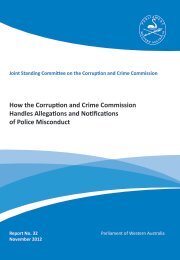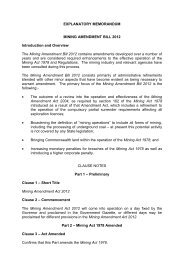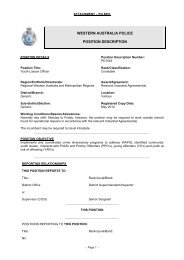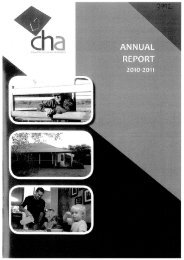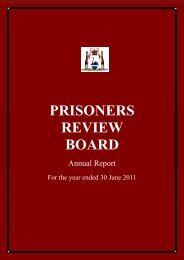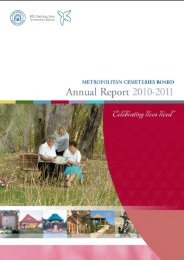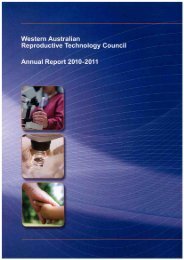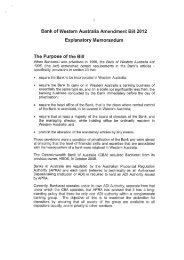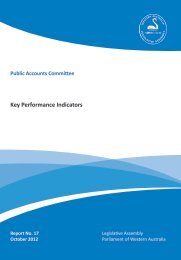Zoological Parks Authority - Parliament of Western Australia - The ...
Zoological Parks Authority - Parliament of Western Australia - The ...
Zoological Parks Authority - Parliament of Western Australia - The ...
Create successful ePaper yourself
Turn your PDF publications into a flip-book with our unique Google optimized e-Paper software.
<strong>Zoological</strong> <strong>Parks</strong> <strong>Authority</strong> ANNUAL REPORT 2012<br />
Disclosures and Legal Compliance<br />
Financial Statements<br />
<strong>Zoological</strong> <strong>Parks</strong> <strong>Authority</strong><br />
Notes to the Financial Statements for the Year Ended 30 June 2012 continued<br />
Where market-based evidence is available, the fair value <strong>of</strong> land and buildings<br />
is determined on the basis <strong>of</strong> current market buying values determined by<br />
reference to recent market transactions. When buildings are revalued by<br />
reference to recent market transactions, the accumulated depreciation is<br />
eliminated against the gross carrying amount <strong>of</strong> the asset and the net amount is<br />
restated to the revalued amount.<br />
In the absence <strong>of</strong> market-based evidence, fair value <strong>of</strong> land and buildings is<br />
determined on the basis <strong>of</strong> existing use. This normally applies where buildings<br />
are specialised or where the land use is restricted. Fair value for existing use<br />
assets is determined by reference to the cost <strong>of</strong> replacing the remaining future<br />
economic benefits embodied in the asset, i.e. the depreciated replacement cost.<br />
Where the fair value <strong>of</strong> buildings is determined on the depreciated replacement<br />
cost, the gross carrying amount and the accumulated depreciation are restated<br />
proportionately.<br />
Land and buildings are independently valued annually by the <strong>Western</strong> <strong>Australia</strong>n<br />
Land Information <strong>Authority</strong> (Valuation Services) and recognised annually to ensure<br />
that the carrying amount does not differ materially from the asset’s fair value at the<br />
end <strong>of</strong> the reporting period. Valuation Services performs a physical site inspection<br />
<strong>of</strong> buildings every three years and the cost <strong>of</strong> acquisitions by the <strong>Authority</strong><br />
between the physical inspections is considered to approximate their fair value.<br />
Works <strong>of</strong> art are independently valued by a qualified valuer every three years on<br />
the basis <strong>of</strong> fair value, determined using current market buying values. <strong>The</strong> cost<br />
<strong>of</strong> acquisitions by the <strong>Authority</strong> between valuations is considered to approximate<br />
their fair value.<br />
<strong>The</strong> most significant assumptions in estimating fair value are made in assessing<br />
whether to apply the existing use basis to assets and in determining estimated<br />
useful life. Pr<strong>of</strong>essional judgement by the valuer is required where the evidence<br />
does not provide a clear distinction between market type assets and existing<br />
use assets.<br />
Refer to note 25 ‘Property, plant and equipment, infrastructure’ for further<br />
information on revaluations.<br />
Derecognition<br />
Upon disposal or derecognition <strong>of</strong> an item <strong>of</strong> property, plant and equipment<br />
and infrastructure, any revaluation surplus relating to that asset is retained in the<br />
asset revaluation surplus.<br />
74<br />
Asset revaluation surplus<br />
<strong>The</strong> asset revaluation surplus is used to record increments and decrements on<br />
the revaluation <strong>of</strong> non-current assets as described in note 25 ‘Property, plant<br />
and equipment, infrastructure’.<br />
Depreciation<br />
All non-current assets having a limited useful life are systematically depreciated<br />
over their estimated useful lives in a manner that reflects the consumption <strong>of</strong><br />
their future economic benefits.<br />
Depreciation is calculated using the straight line method, using rates which are<br />
reviewed annually.<br />
Estimated useful lives for each class <strong>of</strong> depreciable asset are:<br />
Buildings & Improvements 10 to 40 years<br />
Infrastructure<br />
10 to 40 years<br />
Plant, Equipment & Furniture 3 to 10 years<br />
Motor Vehicles<br />
5 to 10 years<br />
Works <strong>of</strong> art controlled by the <strong>Authority</strong> are classified as property, plant and<br />
equipment. <strong>The</strong>se are anticipated to have very long and indefinite useful lives.<br />
<strong>The</strong>ir service potential has not, in any material sense, been consumed during the<br />
reporting period and so no depreciation has been recognised.<br />
Land is not depreciated.<br />
(h) Impairment <strong>of</strong> assets<br />
Property, plant and equipment, and infrastructure assets are tested for any<br />
indication <strong>of</strong> impairment at the end <strong>of</strong> each reporting period. Where there is<br />
an indication <strong>of</strong> impairment, the recoverable amount is estimated. Where the<br />
recoverable amount is less than the carrying amount, the asset is considered<br />
impaired and is written down to the recoverable amount and an impairment loss<br />
is recognised. As the <strong>Authority</strong> is a not-for-pr<strong>of</strong>it entity, unless an asset has been<br />
identified as a surplus asset, the recoverable amount is the higher <strong>of</strong> an asset’s<br />
fair value less costs to sell and depreciated replacement cost.<br />
<strong>The</strong> risk <strong>of</strong> impairment is generally limited to circumstances where an asset’s<br />
depreciation is materially understated, where the replacement cost is falling or<br />
where there is a significant change in useful life.



